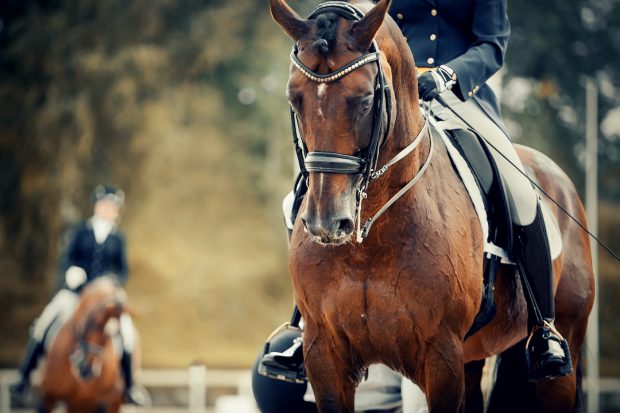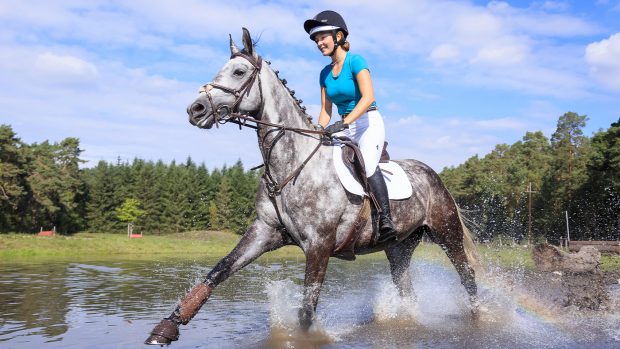Bin it if it rattles! That is the concept behind revolutionary damage sensors that “rattle for eternity” once activated, alerting riders that their riding hat’s safety shield has been compromised.
Cotswolds-based firm BodyCage is pitching hat sensors — which would add £10 to the price of a new hat — to manufacturers as an essential add-on to every riding hat in Britain, akin to blanket acceptance of airbags in cars.
The firm has uncapped a disturbing industry blind spot — that riders are trusting their lives to potentially damaged goods if they have had a fall in their hat or if it has been misused.
BodyCage managing director Alasdair Kirk said that the device, “Trixsys”, responds to a critical lack of knowledge about hat damage. The sensors are not designed to improve a hat’s inbuilt safety level, but act as a “prompt”.
“Adding an audible alarm would be invaluable, especially for parents and riding school owners,” said Kirk.
The device is based on four sets of ball bearings encased in ABS plastic (the same material as a hat’s shell), which begin rattling once a certain level of impact is registered (see below).
But the concept is being viewed with some hesitancy by British Equestrian Trade Association (BETA) members, who question reliability and potential cost to consumers should they be forced to replace hats unnecessarily.
BETA executive director Claire Williams said manufacturers encouraged developments that added to products’ safety and performance, but felt the concept was in its infancy.
“No safety product is launched until conclusive proof is available of its performance in improving safety,” she said, adding that manufacturers found that the sensors were triggered at a relatively low drop height of 82cm, in contrast to usual test heights of 1.5-1.8m.
But Kirk says that impact, not drop height, is significant. “When a hat is empty and bounces, the G-forces sent through it are exaggerated, so the 82cm drop should trigger the sensors,” he said.
Kirk said the sensors were the result of “groundbreaking research” (via independent testing expert SATRA) looking at what happened to a hat’s structure after its first impact.
The sensors, attached to hats containing a 5kg head form, underwent more than 1,000 drop tests, with “usability scenarios” also developed to gauge the rigours placed on riding hats.
Kirk said caution was employed when pre-setting the rattle trigger, under consultation with British Equestrian Federation chief medical officer Peter Whitehead.
“The key thing is if you are looking after your helmet and you don’t fall, it’s no problem. If you misuse it and the alarm goes off, bad luck, but if it goes off in an accident, great,” Kirk said.
Whitehead told Horse & Hound that his initial concerns that consumers may have to shell out unnecessarily for replacement hats were dispelled after BodyCage satisfied him the sensors would not go off in cases of minor damage.
So when would a hat rattle?
BodyCage devised four “usability scenarios” for the average hat, each of which were road-tested.
Scenario 1: normal use
Use of a hat during general riding (including a horse bucking and jumping) through to top-level competition, as long as a fall does not include a direct impact to the hat, together with everyday handling/care such as careful placement into a car boot or on to a wardrobe shelf
Triggers rattle? No
Scenario 2: low impact/misuse
Impact during handling of a hat when not riding, such as it rolling off the back seat of a car (being driven around a corner) or falling on to a carpeted floor after being dropped on to a sofa/chair
Triggers rattle? No
Scenario 3: serious misuse
Everything from kicking a hat around for fun, throwing it on to the floor out of frustration or against a wall in a temper, to careless use such as unfastening a chin strap after dismounting, only for the hat to fall or be knocked off and land on a hard surface. Overheating, for instance in a car, could trigger the sensors, although freezing temperatures make no difference
Triggers rattle? Yes, it should go off
Scenario 4: accidental damage
Direct impact to a hat due to an accident, primarily while riding — a rider falling off a horse or colliding with an object such as a tree. The sensors may not be triggered in a fall when a rider lands on another part of the body
Triggers rattle? Yes, it should go off
|
||
 |
||


 Get up to 19 issues FREE
Get up to 19 issues FREE TO SUBSCRIBE
TO SUBSCRIBE 



